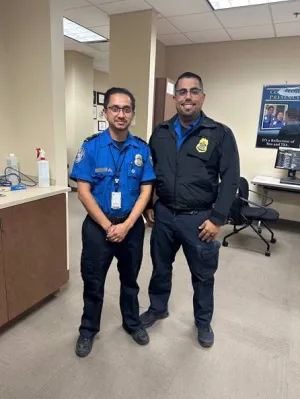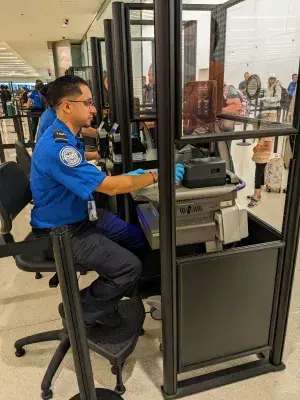 Chicago Midway International Airport TSA Officer Ramon Caballero working at the checkpoint. (Photo courtesy of Ramon Caballero)
Chicago Midway International Airport TSA Officer Ramon Caballero working at the checkpoint. (Photo courtesy of Ramon Caballero)
A routine document check resulted in a passenger fleeing down the halls of Chicago Midway International Airport (MDW). The discovery was made by TSA Officer Ramon Caballero, a rookie fresh off new hire training.
It was his first big checkpoint catch, having donned the TSA blue uniform only for a few weeks. In his seven months with the agency, Caballero has made two fraudulent ID catches just weeks apart.
“Spotting counterfeit IDs has never been an easy task,” MDW Assistant Federal Security Director George Baker said. “It doesn’t take a special eye to make these catches, but it does take attention to detail.”
At the checkpoint, officers are often greeted with an onslaught of busy, out-of-patience travelers. Caballero was still in training, learning how to remain focused on TSA’s security mission while keeping passenger lines moving smoothly.
Caballero was stationed at the Travel Document Checker (TDC) area for his initial Phase 1 On-the-Job-Training. TSA Officer Ivan Ruiz was coaching the rookie on using the light and loupe, a round magnification device used to see small details more closely, to analyze an ID.
During this hands-on training, a passenger approached the counter and presented their ID and boarding pass. Caballero inspected the ID but decided something didn’t feel right about the document. Upon closer inspection, he thought it looked like ID had been tampered with.
Caballero voiced his concerns to Ruiz. A lead transportation security officer came over and helped determined the ID was counterfeit.
“This was my first big catch on the job,” Caballero said. “It felt good not only because I was a new hire that was still in training, but to see firsthand that what we [TSA] do at the checkpoint is important.”
Four months later, Caballero found himself in a situation reminiscent of his first big catch. He was again stationed at the TDC, but now in Phase 2 of his new hire training.
A passenger presented Caballero an Illinois ID, which he placed into the Credential Authentication Technology (CAT) machine. The procedure verified the passenger’s status, but Caballero noticed the ID’s picture looked wrong. Caballero trusted his gut to explore the issue.
He placed the ID under the UV light for an additional check. Under the glowing light, he saw the security features on the back of the ID were not consistent with an authentic Illinois ID.
Caballero requested help from his network, flagging down a passing security training instructor (STI). As the STI approached the TDC location, the passenger became increasingly agitated.
Caballero showed the STI the strange security features on the back of the ID. The STI examined it and determined the ID contained abnormal inkjet features. The ID was counterfeit.
At that moment, the passenger turned and sprinted away from the security checkpoint, into the public area and out of the airport.
TSA’s Office of Intelligence & Analysis - Field Intelligence conducted an investigation into the passenger and discovered he had several felony warrants and priors for weapons violations, armed robbery, burglary and possession of a stolen vehicle.
“TSO Caballero exemplifies all of TSA’s core values,” Baker said. “He has impressed his leadership from day one by exampling a high-level of professionalism. I was not surprised he thwarted the plans of the two offenders. These catches are remarkable because they exemplify how the integrity in the screening process improves our chances of detecting threats regardless of years’ experience.”
by Kimberlyn Pepe, Strategic Communications and Public Affairs


